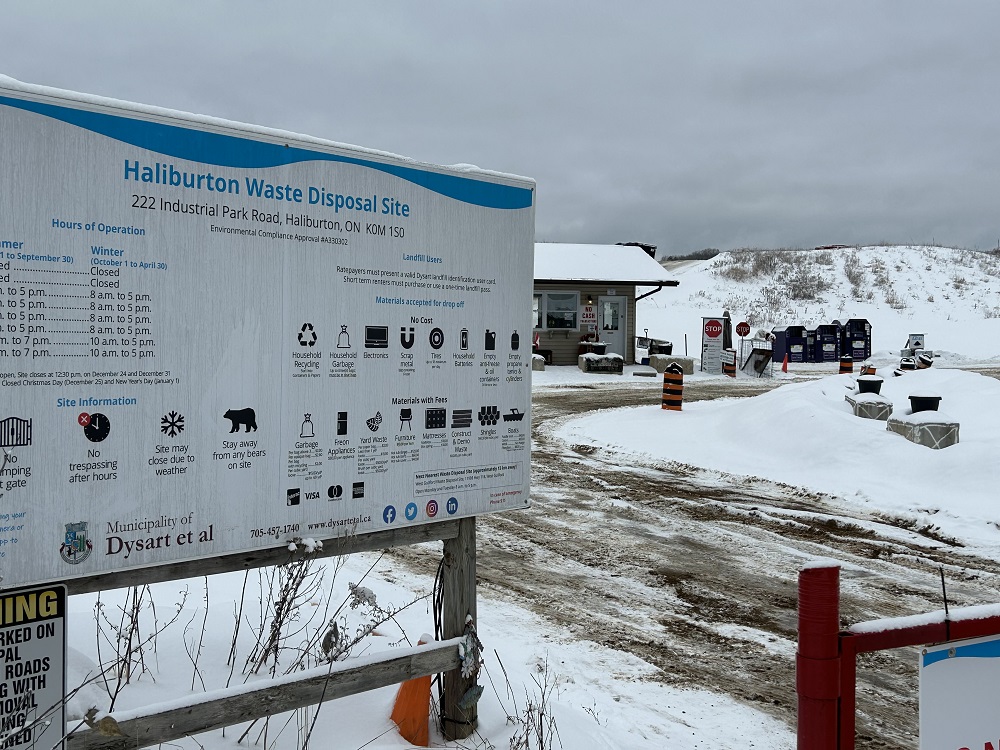Discussions surrounding future investments at the Haliburton landfill site dominated second draft budget deliberations of Dysart et al council Jan. 13.
After John Watson, the township’s manager of environmental services, informed council his department was looking at a $400,000 year-end shortfall in 2022, due to a substantial increase in construction and demolition waste costs, some elected officials sought further clarity on what Watson called “a tough situation.”
Through 2022, Dysart saw a 38 per cent increase over the prior year in the amount of construction and demolition waste dropped off at its three landfill sites, a 41 per cent increase in the number of hauls completed, and a 112 per cent increase in the cost of hauling. All municipal waste collected in Dysart is shipped out of town.
“This dramatic increase is reflective of our local economy – people are renovating their homes extensively, so the amount of material we’re managing has increased dramatically and the price to haul and process construction and demolition waste has increased dramatically,” Watson said.
To offset this increase, Watson is proposing the township up its waste collection fees. Furniture drop-offs are doubling, up to $20; the cost per cubic yard of construction and demolition waste is going from $60 to $100; while a mixture of garbage, recycling, construction, and demolition waste is going from $120 per cubic metre to $200.
Watson said the main issue is the township charges for waste per cubic metre, while its hauling contractor bills per metric ton. Since Dysart doesn’t have a scale at any of its landfill sites, it’s not capable of charging per metric ton.
Deputy mayor Walt McKechnie suggested council approve the purchase of a scale, estimated to cost around $150,000. The township has $120,000 in reserves earmarked for the project. Coun. Pat Casey also suggested the township explore building a shelter to store all construction and demolition waste, so the municipality isn’t incurring extra costs in water weight if materials get wet.
CAO Tamara Wilbee said staff would work on bringing proposals back for each project later this year.
Tax increase sitting at 2.34 per cent
Treasurer Barbara Swannell said the township’s second draft of the 2023 budget called for a 2.34 per cent increase to the municipal portion of resident’s tax bills, down from the 8.9 per cent that was included in the first draft.
This increase would equate to an additional $7.22 per $100,000 worth of assessment for residential properties, $10.71 per $100,000 for commercial properties, and $12.41 per $100,000 for industrial properties.
Total expenditures across the municipality are just north of $21 million, with $11 million to be covered by the tax base, $6.7 million from other non-tax revenue and $3.5 million from provincial and federal grants. Individual department expenses are as follows: general governance $1,659,148; protective services, including police, fire and EMS, $3,791,443; transportation services $7,587,495; environmental services $4,404,970; recreation and culture $2,908,304; planning and development $697,644; health services $190,250; and social and family services $20,501.
Capital expenditures for the year will top out at just over $5.2 million, up from around $3 million in 2022. Over $2.1 million will be spent on roads construction, with $1.1 million earmarked for new vehicle and equipment purchases. There’s also $300,000 included to purchase new playground equipment for Head Lake Park.
Municipal reserves are expected to take a hit in 2023, down to $4,056,972 from $5,601,472 in 2022.
“When we first started out, our [tax rate increase] was over 20 per cent, so we’ve done a pretty good job of tearing it down,” said mayor Murray Fearrey.
“I think this is a great budget,” remarked Coun. Barry Boice.
Council will reconvene for further budget talks Feb. 10.





